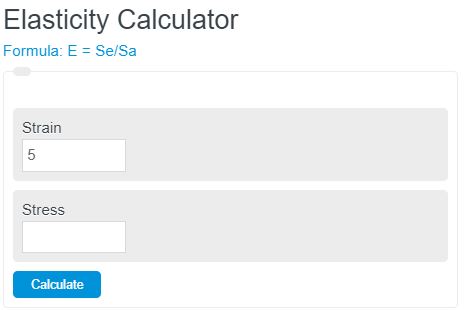Enter the stress and strain acting on the material into the elasticity calculator. The calculator will return the Elastic Modulus of that material.
- Poisson’s Ratio Calculator
- Power-to-Weight Ratio Calculator
- Newton’s Second Law Calculator
- Young’s Modulus Calculator
Elasticity Formula
The following formula is used to calculate the elastic modulus of a material.
E = Se/Sa
- Where E is the elastic modulus
- Sa is the strain
- Se is the stress
It’s important to note that this is strain and stress in the same direction, i.e. axial.
Elasticity (Physics) Definition
Elasticity is a fundamental concept in physics that describes the property of materials to deform under the application of external forces and return to their original shape when the forces are removed. It measures how much a material can stretch or compress when subjected to stress.
When a force is applied to an object, it generates stress, causing the object to change its shape.
Elastic materials can absorb this stress and store potential energy. As a result, they can undergo temporary deformation while maintaining their original structure. Once the external force is removed, the stored energy is released, causing the material to return to its initial state.
How to calculate elasticity?
How to calculate elasticity
- First, measure the strain on an object
Measure the strain on an object using proper instrumentation.
- Next, measure the stress on an object
Using the same instrumentation/press, measure the stress on the object.
- Calculate the elastic modulus
Calculator the elastic modulus using the formula above.
FAQ
What is the difference between stress and strain?
Stress is the force applied to a material, causing deformation, measured in units of pressure (e.g., Pascals). Strain, on the other hand, is the extent of deformation or displacement of a material relative to its original length, and it is dimensionless (a ratio).
How does temperature affect the elasticity of materials?
Temperature can significantly affect the elasticity of materials. Generally, as temperature increases, materials tend to become more ductile and less elastic. This is because the atomic or molecular structures have more energy to move, making the material more pliable.
Why is the concept of elasticity important in engineering?
Elasticity is crucial in engineering because it helps engineers design structures and materials that can withstand applied forces without permanent deformation. Understanding elasticity allows for the creation of buildings, bridges, and machinery that can endure stress and strain over time.
Can all materials return to their original shape after deformation?
Not all materials can return to their original shape after deformation. Materials that can do so are known as elastic materials. In contrast, plastic materials undergo permanent deformation when subjected to stress. The ability to return to the original shape depends on the material’s elastic limit – the maximum stress that it can withstand without undergoing permanent deformation.

